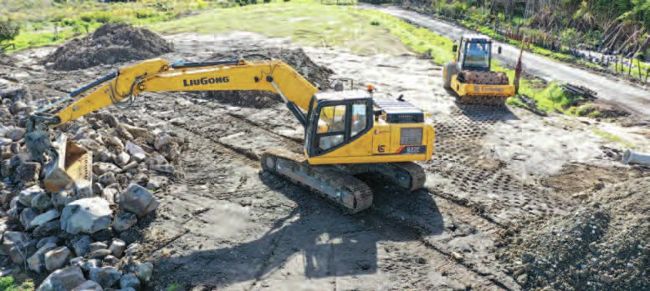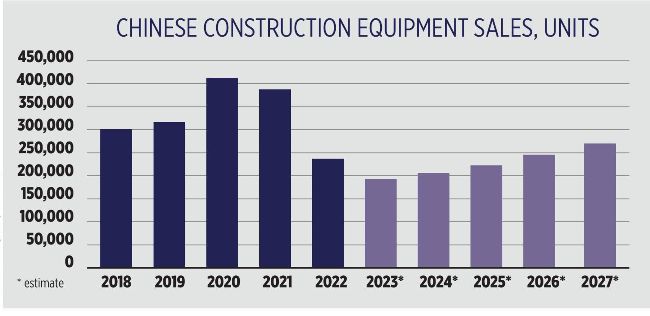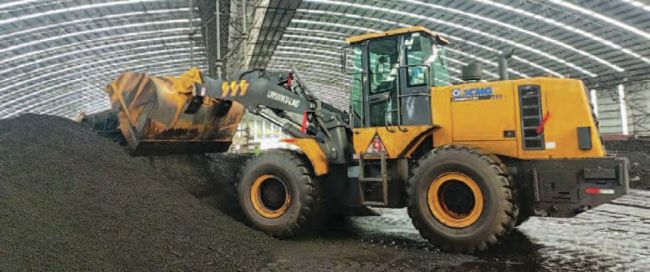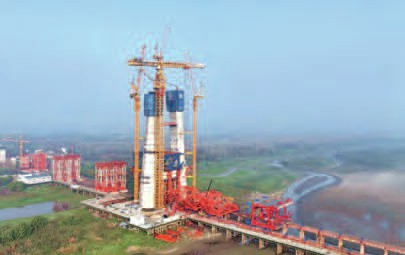A MORE STABLE (AND GREENER) INDUSTRY
Construction in China has followed the path of the wider economy – tremendous highs followed by deep lows. However, discovers Andy Brown, the extreme nature of the industry could be a thing of the past and transitions to a greener construction economy are well under way
I think electric is a real revolution for our industry
While construction is a cyclical market and therefore the construction sectors of all counties experience ups and downs, the Chinese market has been in a league of its own. Fantastic highs have often preceded deep lows.
While most of the rest of the world saw their wider economies (including their construction sectors) suffer in 2020 due to the impact of the Covid-19 pandemic, China saw very high sales in 2020 and 2021 thanks to government stimulus spending. However, sales dropped steeply in 2022 due to less of this finance being available, as well as the Chinese government’s zero tolerance approach to Covid-19, which severely impacted businesses.
The Chinese economy is predicted to grow by 5.4% in 2023 following modest growth of 3% in 2022, according to a report from GlobalData as the country benefits economically from the lifting of the country’s zero-Covid policy, as well as institutional reforms.
In August 2022, the Chinese government announced approximately US$1 trillion of investment in infrastructure megaprojects, providing a boost to construction and related activities. GlobalData projects that construction activities in China will grow at an average annual rate of 9.3% over 2023-25.
Recovery in progress
China’s economy began 2023 on a strong note with a 4.5% growth in Gross Domestic Product (GDP) in Q1, 2023, on an annual basis, up from 2.9% in Q4 2022. The rebound was driven mainly by consumption, with retail sales growing by 10.6% on an annual basis in March 2023, the highest level since June 2021. Industrial production also showed steady growth, up 3.9% in March 2023 compared to 2.4% in January and February 2023 combined.
Industry experts Off-Highway Research expect the construction equipment market to continue to fall in 2023, but at a slower rate of decline, to settle at just below 195,000 units.
The Chinese economy is expected to grow 5.4% in 2023

Zeng Guang’an, Chairman of LiuGong
Zeng Guang’an is Chairman of LiuGong, one of the biggest OEMs in China. He confirms that the Chinese market dropped markedly in 2022 and says that LiuGong is increasing its investment in overseas markets in order to balance this out.
“Last year, in general, the Chinese market dropped a lot. Especially some products; excavators by almost 50% and wheeled loaders almost 30%,” he says.
“This is a big drop. But, overseas, we grew 40%; so we balance domestic and overseas. That’s a strategy we went for a long time ago. Secondly, we have some products such as dozers, mining trucks, and aerial platforms that are growing very fast in China.
” A real recovery is expected during the period of the 15th Five Year Plan (2026- 2030), primarily as a result of increased sales of compact equipment and the returning replacement demand; by then the market may return to 270,000-300,000 units, but even that volume is still lower than in the past.
Mr. Liu, VP of XCMG and general manager of XCMG overseas, believes that the Chinese market will begin to recover. “I think maybe in the second quarter of this year we can see a strong recovery. Even in March we saw some products, like cranes, have a very strong recovery.
Like LiuGong, XCMG is experiencing strong growth in overseas markets, with the company’s recent results showing that for the first quarter of the year ‘internationalization revenue’, sales from markets outside China, exceeded 10.6 billion yuan – a record amount in a single quarter for the company.
A significant challenge to the future Chinese market lies in lower demand from the real estate sector, which has been closely allied to overall demand for equipment. In light of the saturated population and overheated supply,
demand for new housing projects may decline.
The property developer Evergrande recently released its restructuring plan, highlighting doubts about the company’s prospects of recovery. Evergrande was at the centre of a crisis in the Chinese property sector after it defaulted in 2021 with liabilities of around US$300 billion, including offshore debt of US$22.7 billion.
In March President Xi unveiled government changes with some new figures in key roles, such as Li Qiang as the country’s new Premier. Both Mr Liu and Chairman Zeng express their belief that this new-look government will be good for business.
Transport investment
When it comes to infrastructure projects, transport has received a large part of government funding. China has, by some distance, the longest high-speed railway network in the world at approximately 40,000km with reports suggesting that the country plans to build another 2,500km in 2023. Many transport projects in China require the use of Tunnell Boring Machines (TMBs); recently the largest slurry TBM in China’s Hunan Province broke through, marking the completion of the right line tunneling of the Xiangya Road river-crossing tunnel in Changsha City. The 15.01m slurry TBM ‘Xingsheng’ is manufactured by China Railway Construction Heavy Industry Corporation Limited (CRCHI).

The 15.01m slurry TBM ‘Xingsheng’ breaking through the Xiangya Road river-crossing tunnel in China
As the largest river-crossing tunnel in Hunan Province the Xiangya Road river-crossing tunnel is considered a key infrastructure project of Hunan Province, as well as a major livelihood project of Changsha City, the provincial capital. The total length of the tunnel is 4,180m. The left line TBM tunnel is 1,429 meters long, and the right line TBM tunnel is 1,425 meters long. It is said to be the first two-way six-lane river-crossing tunnel in Changsha and is scheduled to open to traffic this year.
Another TBM, the 15.01m super-large diameter slurry TBM ‘Zhenxing’ recently broke through the left line of Hengqin Mangzhou Tunnel in Zhuhai City, which is 800km away from Changsha. The TBM is also manufactured by CRCHI.
Hengqin Mangzhou Tunnel is located in Guangdong-Macao Deep Cooperation Zone. The tunnel is about 3km long and is planned to open to traffic in 2024.
Is hyperloop coming to China?
A project that hasn’t broken ground yet but is being considered is a hyperloop train line between Shanghai and Hangzhou, reports South China Morning Post. The 150km-long invacuum tunnel maglev system will allow trains to travel up to 1,000km/h.
The Chinese Academy of Engineering and rail authorities are reported to have commissioned a “comprehensive assessment on the candidate construction sites for ultra-high speed pipeline maglev system demonstration line”, and the two wealthiest cities on the east coast emerged as winners, according to a report published in the Chinese-language journal Railway Standard Design.

Mr. Liu, VP of XCMG and general manager of XCMG overseas
The project team said that they considered several critical factors in the competing hyperloop bids. The economic potential of each line was evaluated according to factors such as population density, economic activity and existing transport infrastructure. Several candidate lines competed for the hyperloop project in China, including the lines of: Beijing-Shijiazhuang, Guangzhou- Shenzhen and Chengdu-Chongqing.

Major Chinese OEMs are increasingly targeting overseas markets for their sales
More and more people realise the electric driven vehicle can be a very important approach to decarbonize
If plans go ahead then the line is expected to be operational by 2035. Travel time between the cities of Shanghai and Hangzhou will be cut to 15 minutes, compared with three hours by road or one hour by high-speed rail – a significant reduction.

Source: Off-Highway Research
Alternative power
A study published last year by the World Bank reported that China emits 27% of global carbon dioxide and a third of the world’s greenhouse gases but added that the country was “well positioned to meet its climate commitments and transition to a greener economy.” China has embraced alternative power – in the automotive industry, for example, the government has imposed policies to encourage the adoption of plug-in electric vehicles; by 2030 the aim is that 40% of cars sold in China will be electric. This change may not be happening as quickly in construction, but there is no doubt that it is occurring.

Sany’s SW956E electric loader has an onboard intelligent system that can automatically adjust power output based on load, speed, and other conditions
For example, SDLG has produced electric excavators and wheeled loaders, such as the E660HEV electric excavator. The OEM says it has a high-capacity lithium iron phosphate battery, characterised by battery life of up to six hours and fast charging, and installed with a permanent magnet synchronous motor with a small volume and a high power density.
At ConExpo in the US Sany showed over thirty machines with its electric-powered excavator and wheeled loader front and centre. In a press release the company said that, “State-of-the-art solutions demonstrate the company’s climate commitment is its carbon monitoring platform, which is developed in partnership with Rootcloud, a leading industrial IoT solution provider.
” The OEM says that its SY19E electric mini excavator is equipped with a high-torque permanent magnet synchronous motor and its proprietary integrated electric drive system, while its SW956E electric loader, supercharged by a high-power permanent magnet synchronous motor, is capable of delivering an instantaneous torque of 2400Nm.

Sales of wheeled loaders declined in China in 2022

XCMG Machinery’s XGT15000-600S, the world’s largest tower crane, worked on a bridge project in 2022
Chairman Zeng from LiuGong says that electric machines have “huge advantages” over diesel, citing the lack of noise and emissions and that they can work in city centres at all times of the day. He comments that, “the battery is the main trend for the world because, compared to the other solutions, such as hydrogen. I think it’s much better. I think electric is a real revolution for our industry.”
BELT AND ROAD DEBTS MOUNT
China’s Belt and Road Initiative (BRI) infrastructure finance programme has been hit by an increasing amount of bad loans, with more than US$78 billion worth of borrowing turning sour over the past three years, according to research organisation Rhodium Group. The figures reveal that approximately US$78.5 billion of loans from Chinese institutions to roads, railways, ports, airports and other infrastructure projects around the world were renegotiated or written off between 2020 and the end of March this year.
The Rhodium Group says that this is more than four times the US$17 billion in renegotiations and write-offs in the three years from 2017 to the end of 2019 – although it should be noted that the period of 2020 to 2023 includes the impact of the pandemic.
Another report showed that China is pivoting away from investment in new projects beyond its borders under the BRI as the country is increasingly having to be a lender of resort for developing nations struggling to repay their BRI debts.
The study by AidData, the World Bank, the Harvard Kennedy School, and the Kiel Institute for the World Economy found China had undertaken 128 rescue loan operations across 22 debtor countries worth US$240 billion by the end of 2021.
Cost considerations
The LiuGong chairman does acknowledge that one of the problems with electric power is cost, with some equipment two or even three times as expensive, meaning that it is something that is being taken up more by the bigger players.
However, he says that total cost of ownership of electric machines is less, and expects this message to permeate through the industry.
“Based on our experience in China the battery machine can reduce the cost by 60%-70% [over the machine’s lifetime]. So this is very important for the customer, fuel and oil prices are going higher, this is a big saving.”
Regarding the topic of alternative power, Mr Liu from XCMG comments that, “I think more and more people realise the electric driven vehicle can be a very important approach to decarbonize. I think in the next five years there will be more and more products; even one third.” Regarding sales being low for electric equipment he says, “We will never give up in this direction; XCMG is firmly invested for green.
” The Chinese construction industry has experienced seismic ups and downs in recent years. The future for construction should be more stable with growth at a slower – but more sustainable – rate, and a sector that looks to be increasingly putting sustainability at the front of its plans.
iC